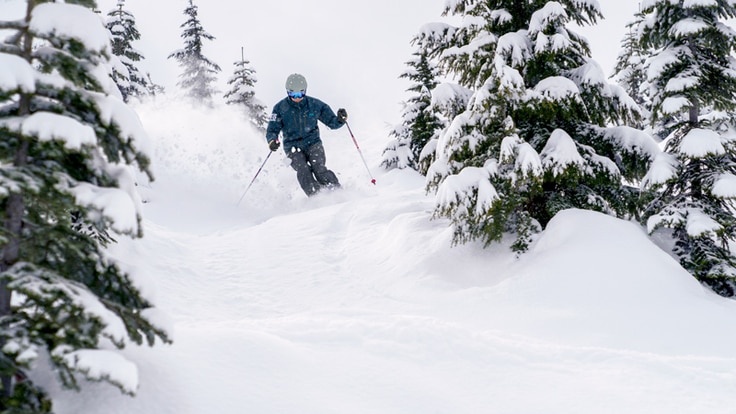Learning to ski can open doors to a lifetime of winter fun and connection to the mountains. Why learn to ski? Skiing offers many benefits. It's a sport you can enjoy with friends as well as the entire family, young and old. You get access to unmatched mountain terrain. Skiing also gets your heart rate up, burns calories and works your muscles.
This article and video describe the basic techniques to learn how to ski, including:
- The proper ski stance
- How to glide
- How to walk uphill
- How to ski in a wedge
- How to do a wedge turn
- How to link wedge turns
The first step is to get to know your gear.
- Practice getting in and out of your ski boots and clicking into your bindings. Watch our video to learn how to put on skis. Read more tips in the article How to Put on Ski Boots and Skis.
- Read more beginner skiing tips, including how to carry your skis.
Video: How to Ski
Learn the Proper Ski Stance
Maintaining a proper athletic ski stance keeps you balanced and puts you in a better position to control your skis.
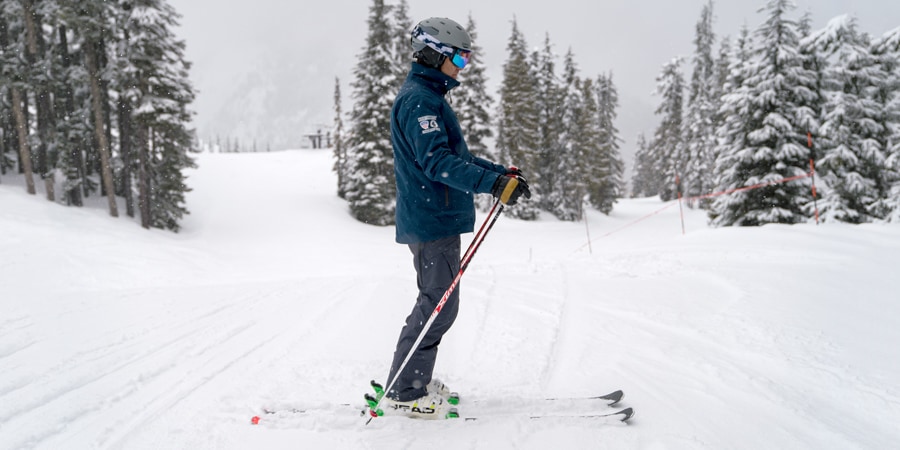
- Stand relatively tall with your feet about shoulder-width apart.
- Flex your ankles and tilt your shins forward.
- Keep your shoulders slightly in front of your hips with weight centered over both feet.
- Keep your arms slightly out in front and off to the side. Hold your poles with the tips pointed back, behind your feet.
- Look toward where you're going, not down at your skis.
Tip: Hop up and down with both feet. The stance when you land is where you want to be.
How to Glide on Skis
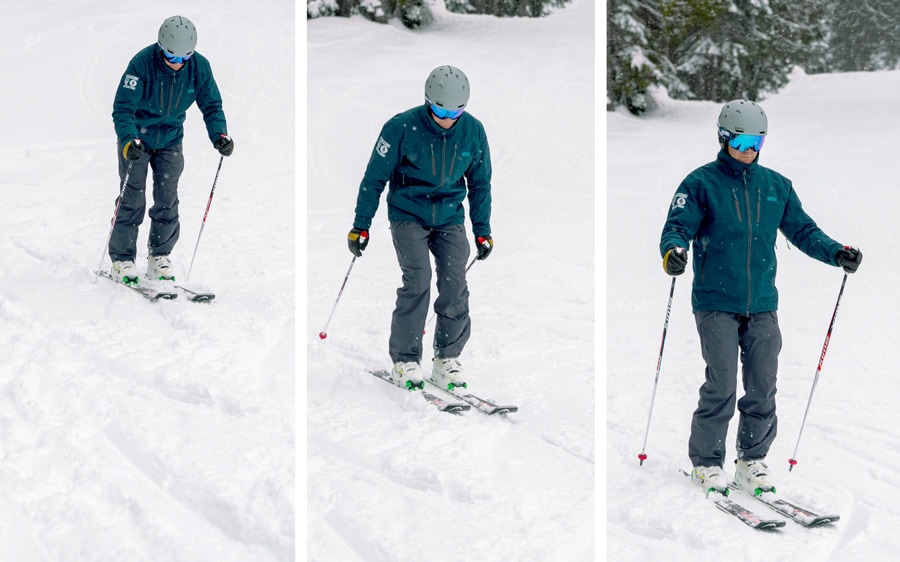
After clicking into your skis, you'll learn what it's like to balance and move on skis. Gliding on flat terrain is one of the first movements you'll make.
- Push off with your ski poles (one on each side).
- Flex your ankles.
- Keep your shins tilted forward and your weight centered over your feet as you move with your skis.
Tip: It may be easier to glide on a completely flat area with one ski first to get the feel of it.
Next, try gliding down a gentle hill. This gets you familiar with balancing on skis that are sliding down a gentle slope.
- Point your skis downhill, push off with your poles and glide to a natural stop.
- Practice gliding and balancing over short distances and on small slopes or inclines.
How to Walk Uphill on Skis
To navigate a ski area, you'll need to learn how to walk uphill on skis. When you first learn to ski, you'll also have to get up smaller slopes to practice since you won't be using a chairlift or surface lift, such as a rope tow, just yet. There are two approaches to walking uphill: Most beginners may find it easier to side-step.
How to side-step uphill:
- With skis parallel to each other, face across the slope perpendicular to the fall line so you don't slide down. (The fall line refers to the most direct route down a slope, or the line of gravity).
- Roll your skis slightly on their sides or edges toward the slope.
- Push off of the bottom (or downhill ski) and step with the uphill ski sideways up the hill. Then bring the other ski parallel to it.
- Take small steps and lean your lower legs (rather than your butt or shoulders) into the slope.
How to herringbone uphill:
- Position your skis into a V shape as you face the hill. (Your ski tips should be at 10 o'clock and 2 o'clock with tails closer together but not touching or overlapping.)
- Relax your knees to the inside so the skis are on a slight edge inward.
- Take small steps up the hill, maintaining the V shape.
- Your skis will leave a herringbone pattern in the snow.
Tip: Make wider V's to get up steeper hills.
How to Ski in a Wedge (aka Triangle or Pizza)
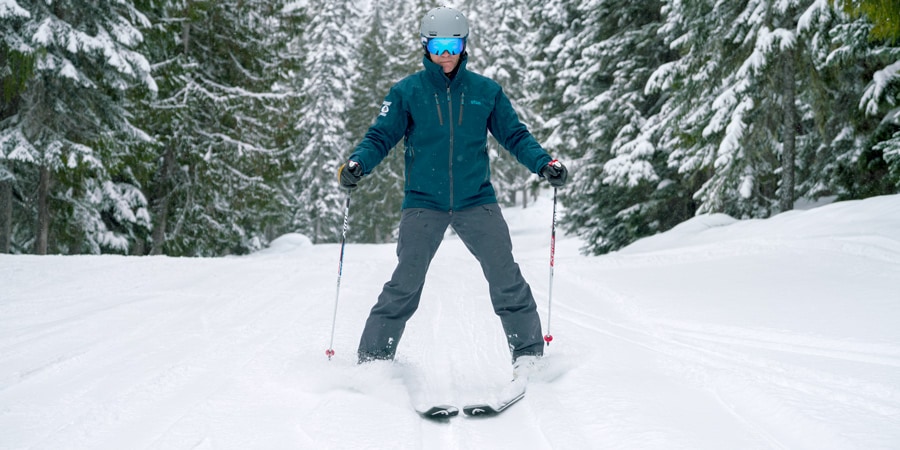
Once you start moving on skis, you'll learn how to control your speed and stop by forming a wedge with your skis. It's also called the triangle or pizza. You'll use the wedge to control your speed, stop and make turns, so practice a lot.
- On flat terrain, practice making a wedge with your ski tips fairly close together and tails farther apart. Your skis should remain relatively flat on the snow.
- On a short gentle slope with a flat runout, practice holding the wedge stance as you glide down and come to a natural stop.
- Next, walk up a small hill, make a triangle at the top and go down. Control your speed by changing the triangle size: As you're wedge gets wider, you'll go slower.
- Make your wedge wide enough to come to a stop. To start downhill again, make your wedge narrower and push off with your poles.
- Practice maintaining a consistent speed, slowing down and stopping.
Tip: Keep your knees relaxed and open. Avoid squeezing your knees together; this will put your skis on an edge and make it harder to move.
How to do a Wedge Turn
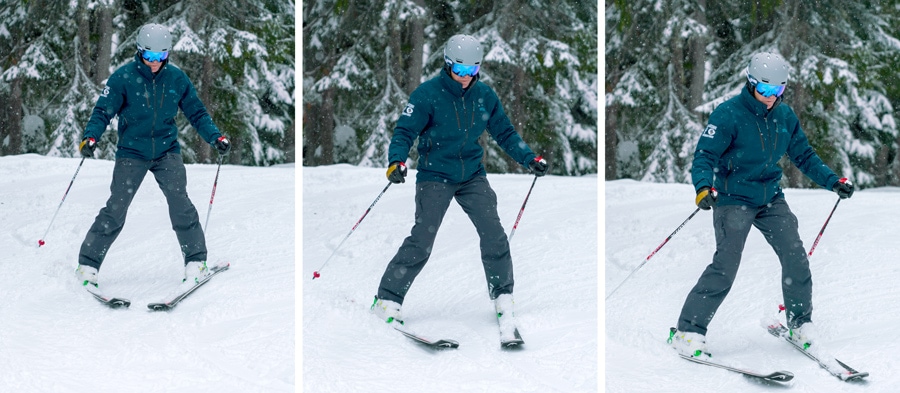
Once you've explored gliding in a wedge, you're ready to learn how to make basic turns. You'll learn how to control your speed and direction by the shape of your turn.
- While gliding in a wedge, use your legs to twist both skis in the direction you want to go. Keep your skis in a wedge shape the entire time.
- Put slightly more weight on the outside/downhill ski to turn. To turn right, put more weight on your left foot. To turn left, put more weight on your right foot.
- To stop, turn so you're positioned across the slope.
Tips: While practicing the wedge turns, steer using your legs and feet, not your upper body. Keep skis relatively flat and maintain the size and shape of the wedge. Keep an athletic stance with weight centered over your feet: Leaning back is the most common mistake skiers make.
How to Link Wedge Turns
Once you've practiced turning in each direction, it's time to link those wedge turns. Linking turns is how you ski down the mountain, control your speed and control where you want to go.
- Turn in one direction by steering the wedge by twisting your legs and feet and slightly shifting your weight slightly to the outside ski. Keep turning until you're just facing across the hill.
- Then go back to a neutral stance and glide straight as you transition to the next turn.
- Steer in the opposite direction by twisting legs and shifting weight slightly to the outside ski.
- Maintain a consistent wedge size and shape. Glide rather than dig into your edges.
- Use your lower body to steer your skis. Keep your upper body relaxed.
- Vary the turn shape to control your speed.
Remember: Safety is your responsibility. No internet article or video can replace proper instruction and experience—this article is intended solely as supplemental information. Be sure you're practiced in proper techniques and safety requirements before you engage in any outdoors activity.
Related Articles
<
